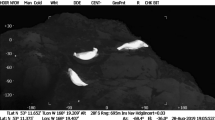Abstract
A method is developed for processing pictures taken from multicopters in order to identify the number of Caspian seals and their linear sizes on rookeries. A special protocol records the location (coordinates), date, time, survey altitude, the cloudiness across a scale ranging from one to ten, air temperature, wind speed, and picture numbering. A photo software editor (for example, Adobe Photoshop CS5) is used for counting the individuals and taking their measurements. Each seal image is allotted an individual serial number within one picture. By flying over and photographing a rookery at different times of the day, quadcopters allow for an assessment of the daily dynamics of the seal numbers to be made. In cases when the groups under assessment are numerous, counts are recommended to be performed along transects. Knowing the angle of the field of vision (FOV) of the multicopter and the altitude it operates at, the following formula can be applied, “A cathetus lying opposite the angle equals the product of the second cathetus multiplied by the tangent angle,” to calculate the distance between the extreme points of a picture’s diagonal in the International System of Units (m, cm, or mm) (SI). As the resolution in pixels is also known, calculating the size of a pixel in SI can be performed per picture. The measurements of individual seal images in the pictures are converted from pixels into SI units. As a result, the length and the maximum width of the seals can be established, this being of importance for identifying the size structure of the seal concentrations on rookeries. Subsequently, having compiled a size–age key, the age structure of the groups of seals on rookeries can be calculated.






Similar content being viewed by others
REFERENCES
Belikov, R.A., Prasolova, E.A., Krasnova, V.V., Litovka, D.I., and Bel’kovich, V.M., Experience of using remotely piloted and tethered unmanned aerial vehicles for the study of the White Sea and Anadyr beluga whales, in Morskie mlekopitayushchie Golarktiki. Sbornik nauchnykh trudov (Marine Mammals of the Holarctic: Collection of Scientific Papers), Moscow, 2018, vol. 1, pp. 45–50.
Grammatin, A.P., Metody sinteza opticheskikh sistem. Uchebnoe posobie (Methods for the Synthesis of Optical Systems: Tutorial), St. Petersburg: St.-Peterburg. Gos. Inst. Tochnoi Mekhaniki i Optiki, 2002.
Phantom Quick Start Guide. https://www.icover.ru/manuals/DJI_PHANTOM_RUS.pdf.
Phantom 4 Pro. Kratkoe rukovodstvo pol’zovatelya (Phantom 4 Pro Quick Start Guide).
Funding
This work was carried out under a contract with the Kazakh Research Institute of Fisheries LLP within the framework of a state order of the Ministry of Agriculture of the Republic of Kazakhstan to estimate the number of Caspian seals on island rookeries in the Kazakh part of the Caspian Sea in 2015–2017.
Author information
Authors and Affiliations
Corresponding author
Ethics declarations
The authors declare that they have no conflict of interest. This article does not contain any studies involving animals or human participants performed by any of the authors.
Rights and permissions
About this article
Cite this article
Baimukanov, M.T., Zhdanko, L.A., Baimukanov, T.T. et al. A Method for Counting and Identifying the Linear Sizes of Caspian Seals (Pusa caspica) on Rookeries Using Multicopters. Biol Bull Russ Acad Sci 48, 1107–1113 (2021). https://doi.org/10.1134/S1062359021070062
Received:
Revised:
Accepted:
Published:
Issue Date:
DOI: https://doi.org/10.1134/S1062359021070062




